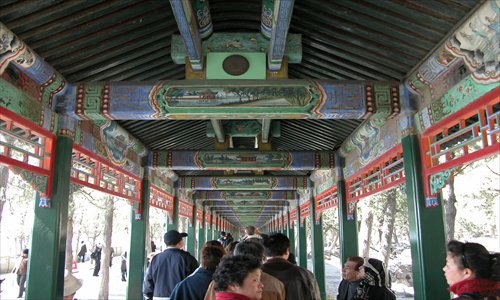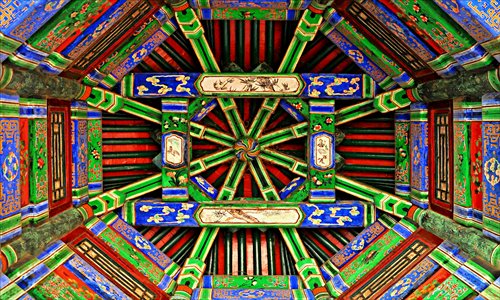HOME >> METRO BEIJING
End of the Corridor?
By Zhang Wen Source:Global Times Published: 2013-7-22 19:03:01

The Long Corridor's Chinese color paintings at the Summer Palace

Suzhou-style painting patterns. Photos: CFP, IC
During the last restoration of the Summer Palace's Long Corridor in 1979, Qin Shulin was among the youngest of 60 painters touching up some of the 18th century walkway's more than 14,000 paintings. Now, the 59-year-old is one of the few active artisans from his generation skilled at caihua, or Chinese color painting, in Beijing.
"Most artists switched to easier, more profitable projects, such as Buddhist paintings or steel sculptures. Others I know are too old and not active anymore," Qin, a landscape painting specialist, said of his peers 34 years ago.
Prior to 1979, the Long Corridor was restored in 1959 and 1940. It is long overdue for a new coat of paint, but the Summer Palace's management faces a dilemma because few artists are up to the task.
"The average painting cycle is 20 years, but restoration has been delayed for so long because few experienced painters can be found. Cultural heritage authorities are wary of ruining existing paintings by hiring unskilled artists," Qin said.
Suzhou-style decorative paintings adorn the Long Corridor and other ancient wooden architecture structures in Beijing, such as the Prince Gong Mansion near Shichahai Lake and Fayuan Temple in Xicheng district.
"Painting used to be a popular profession in old Beijing. The best time I experienced was in the 1970s, when hundreds of painters were competing to be the best. Now, almost all young people prefer to go to university instead of learning such skilled professions," Qin said.
Gao Wei, secretary-general of the Beijing Folk Art Association, noted since the golden era of caihua in the mid to late Qing Dynasty (1644-1912) it has suffered a steady decline.
"Many wooden courtyards have been replaced by high-rise concrete apartments, so such painting doesn't have the demand or application anymore. The demise of this art form has been inevitable," Gao said.
Qin noted low pay, long hours and meticulous brushwork makes caihua an undesirable field for many budding painters.
"You have to climb to the top of the corridor to paint. It's hard work. Nowadays, most painters [in Beijing] are itinerant migrant workers," Qin said, adding few have a mentor to learn from while an apprentice, as was common among his generation.
"Those who paint well set up studios and paint on canvases. They can make several thousand yuan for a single painting. By comparison, the average daily rate for an architecture painter is 300 yuan ($49)," he said.
Yang Baosheng, director of the Beijing Landscape and Traditional Chinese Architectural Engineering Company, admits it is difficult to recruit and retain artists skilled in traditional forms of painting.
"We only have projects two to four months of the year. People don't remain here when we have no work because they can't earn much. Most artists [who leave the company] go on to open independent studios," Yang said of the company, which specializes in architecture painting.
Qin fears caihua will continue struggling to survive in the future. Natural minerals once used in paints have already been replaced by artificial materials, while most clients demand quick, cheap projects rather than slow yet skillful brushwork, said Qin.
"In the past, we used top quality ocher-based paints for dark colors. Now, these are often substituted for inferior materials. Such paints don't endure the sun like they used to," Qin said.
"I want to retire next year, but I believe people will still seek my consultation about architecture painting because there isn't really anyone else."
Posted in: Metro Beijing